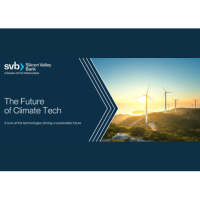The Future of Climate Tech 2024, Presented by Silicon Valley Bank (SVB)
While the challenges to avert climate change remain considerable, the long-term technology trends are clear and bright. It is now cheaper to develop new renewable energy than it is to maintain fossil fuel generation. Roughly 88% of global carbon emissions are now covered by a net zero goal, and policies such as the Inflation Reduction Act (IRA) are beginning to have a meaningful impact on advancing climate tech solutions and businesses. Entrepreneurs and investors are increasingly turning attention to hard-to-abate emissions sources. For instance, we see significant progress in technologies — such as thermal storage to supply industrial heat at over 1400°C and rapidly improving hydrogen electrolysis and fuel cells which help enable decarbonization of previously hard-to-electrify sectors.
Tailwinds for climate tech abound, but the sector is impacted by the decline of overall venture capital (VC) investment, which witnessed the most significant correction since the dot-com bubble burst in 2000. But climate tech has outperformed, with deal activity falling just 14% compared to the 27% witnessed in the overall market. And investors remain committed to the sector. Amongst the most active corporate venture capitalists (CVCs), climate tech now accounts for 11% of deals, up from 2% in 2020. As VC investment declines and runway shortens, our proprietary data suggests climate tech companies are turning toward profitability with more companies seeing improving EBITDA margins year- over-year (YoY) than at any point in recent history.
As the pace of VC fundings slow and exits remain elusive, there is an increasing focus on finding capital for late-stage companies in the form of less dilutive solutions, including corporate debt and project finance. Many late-stage companies in 2021 had the opportunity to tap public markets for capital, but that window is mostly closed given many of the now-public companies have struggled to meet shareholder expectations of sales and profitability growth. M&A markets have not fared much better, with climate tech M&A deal activity down 35% YoY. But so far in 2024, the US innovation economy is showing signs of stability and normalization, late-stage valuations are stabilizing, Series A deal activity is starting to pick up and exits may be on the horizon.
Despite near-term capital challenges, the stage is set for long-term adoption of climate tech solutions. In a world where climate risk is increasingly inherent, the technologies that mitigate that risk will likely flourish by necessity.
DOWNLOAD THE FUTURE OF CLIMATE TECH HERE.
Silicon Valley Bank A Division of First Citizens Bank
-
Alyson Daniel Senior Manager, Integrated Marketing & Strategy - Startup Banking
- June 10, 2024
- Send Email


